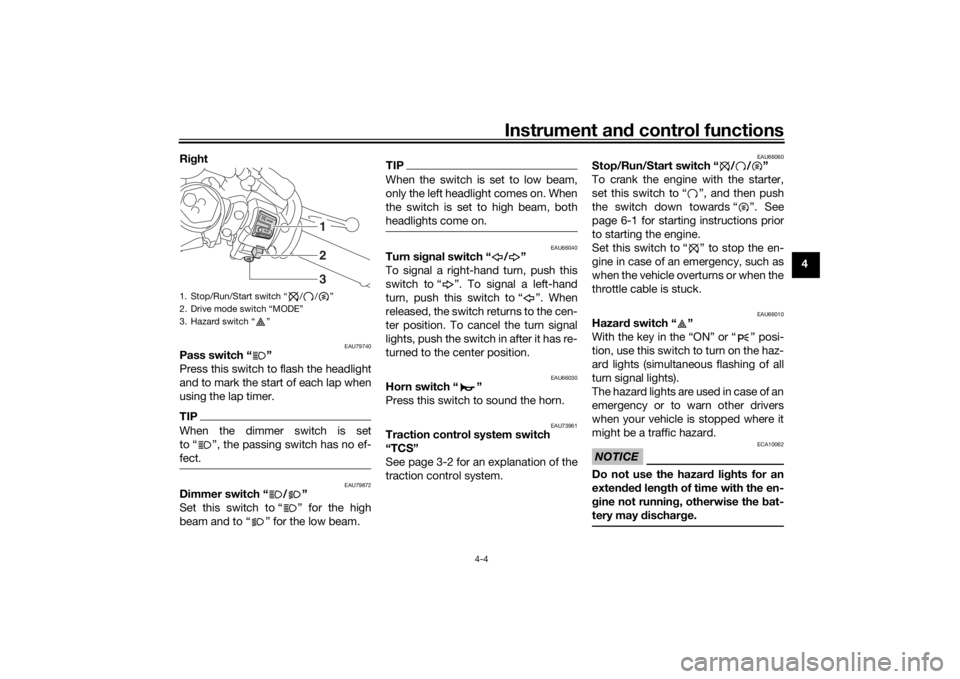light YAMAHA YZF-R6 2020 Owners Manual
[x] Cancel search | Manufacturer: YAMAHA, Model Year: 2020, Model line: YZF-R6, Model: YAMAHA YZF-R6 2020Pages: 112, PDF Size: 5.44 MB
Page 6 of 112

Table of contentsSafety information ............................ 1-1
Description ....................................... 2-1
Left view ......................................... 2-1
Right view ....................................... 2-2
Controls and instruments ............... 2-3
Special features ............................... 3-1
D-mode (drive mode)...................... 3-1
Traction control system .................. 3-2
Quick shift system .......................... 3-4
Instrument an d control functions ... 4-1
Immobilizer system......................... 4-1
Main switch/steering lock............... 4-2
Handlebar switches ........................ 4-3
Indicator lights and warning
lights............................................ 4-5
Multi-function meter unit ................ 4-8
Clutch lever .................................. 4-16
Shift pedal .................................... 4-17
Brake lever.................................... 4-17
Brake pedal .................................. 4-17
ABS .............................................. 4-18
Fuel tank cap ................................ 4-19
Fuel ............................................... 4-19
Fuel tank overflow hose ............... 4-21
Catalytic converter ....................... 4-22
Seats ............................................ 4-22
Rear view mirrors.......................... 4-23
Adjusting the front fork ................. 4-24 Adjusting the shock absorber
assembly.................................... 4-26
EXUP system ................................ 4-28
Auxiliary DC connector ................. 4-29
Sidestand ...................................... 4-29
Ignition circuit cut-off system ....... 4-30
For your safety – pre-operation
checks ............................................... 5-1
Operation an d important ri din g
points ................................................. 6-1
Starting the engine .......................... 6-1
Shifting ............................................ 6-2
Tips for reducing fuel consumption ................................ 6-3
Engine break-in ............................... 6-4
Parking ............................................ 6-4
Perio dic maintenance an d
a d justment ........................................ 7-1
Tool kit ............................................ 7-2
Periodic maintenance charts .......... 7-3
Periodic maintenance chart for the emission control system .............. 7-3
General maintenance and
lubrication chart ........................... 7-5
Removing and installing cowlings and panels ................................... 7-9
Checking the spark plugs ............. 7-13
Canister ......................................... 7-14 Engine oil and oil filter cartridge ... 7-15
Why Yamalube.............................. 7-18
Coolant ......................................... 7-19
Air filter element ............................ 7-20
Checking the engine idling
speed ........................................ 7-20
Checking the throttle grip free play ............................................ 7-21
Valve clearance............................. 7-21
Tires .............................................. 7-21
Cast wheels .................................. 7-24
Adjusting the clutch lever free play ............................................ 7-24
Checking the brake lever free
play ............................................ 7-25
Brake light switches ..................... 7-26
Checking the front and rear brake pads ................................ 7-26
Checking the brake fluid level ...... 7-27
Changing the brake fluid .............. 7-28
Drive chain slack........................... 7-29
Cleaning and lubricating the drive chain ................................. 7-30
Checking and lubricating the cables ........................................ 7-31
Checking and lubricating the
throttle grip and cable ............... 7-31
Checking and lubricating the brake and shift pedals............... 7-32
Checking and lubricating the brake and clutch levers ............. 7-32UBN6E2E0.book Page 1 Friday, December 7, 2018 2:56 PM
Page 7 of 112

Table of contents
Checking and lubricating the
sidestand ...................................7-33
Lubricating the swingarm pivots ...7-33
Checking the front fork..................7-34
Checking the steering ...................7-34
Checking the wheel bearings ........7-35
Battery ...........................................7-35
Replacing the fuses .......................7-36
Vehicle lights .................................7-38
Replacing the license plate light bulb ............................................7-38
Supporting the motorcycle............7-39
Troubleshooting ............................7-39
Troubleshooting chart ...................7-41
Motorcycle care an d stora ge ..........8-1
Matte color caution .........................8-1
Care .................................................8-1
Storage ............................................8-3
Specifications ....................................9-1
Consumer information ...................10-1
Identification numbers ...................10-1
Diagnostic connector ....................10-2
Vehicle data recording ..................10-2
In dex ................................................11-1
UBN6E2E0.book Page 2 Friday, December 7, 2018 2:56 PM
Page 11 of 112

Safety information
1-4
1
tents, can create unstable han-
dling or a slow steering re-
sponse.
This vehicle is not desi gne d to
pull a trailer or to be attached to
a si decar.
Genuine Yamaha Accessories
Choosing accessories for your vehicle
is an important decision. Genuine
Yamaha accessories, which are avail- able only from a Yamaha dealer, have
been designed, tested, and approved
by Yamaha for use on your vehicle.
Many companies with no connection
to Yamaha manufacture parts and ac-
cessories or offer other modifications
for Yamaha vehicles. Yamaha is not in
a position to test the products that
these aftermarket companies produce.
Therefore, Yamaha can neither en-
dorse nor recommend the use of ac-
cessories not sold by Yamaha or
modifications not specifically recom-
mended by Yamaha, even if sold and
installed by a Yamaha dealer. Aftermarket Parts, Accessories, an
d
Mo difications
While you may find aftermarket prod-
ucts similar in design and quality to
genuine Yamaha accessories, recog-
nize that some aftermarket accesso-
ries or modifications are not suitable
because of potential safety hazards to
you or others. Installing aftermarket
products or having other modifications
performed to your vehicle that change
any of the vehicle’s design or operation
characteristics can put you and others
at greater risk of serious injury or
death. You are responsible for injuries
related to changes in the vehicle.
Keep the following guidelines in mind,
as well as those provided under “Load-
ing” when mounting accessories. Never install accessories or carry
cargo that would impair the per-
formance of your motorcycle.
Carefully inspect the accessory
before using it to make sure that it
does not in any way reduce
ground clearance or cornering
clearance, limit suspension travel, steering travel or control opera-
tion, or obscure lights or reflec-
tors.
• Accessories fitted to the han- dlebar or the front fork area can
create instability due to improp-
er weight distribution or aerody-
namic changes. If accessories
are added to the handlebar or
front fork area, they must be as
lightweight as possible and
should be kept to a minimum.
• Bulky or large accessories may seriously affect the stability of
the motorcycle due to aerody-
namic effects. Wind may at-
tempt to lift the motorcycle, or
the motorcycle may become
unstable in cross winds. These
accessories may also cause in-
stability when passing or being
passed by large vehicles.
• Certain accessories can dis- place the operator from his or
her normal riding position. This
improper position limits the
freedom of movement of the
UBN6E2E0.book Page 4 Friday, December 7, 2018 2:56 PM
Page 12 of 112

Safety information
1-5
1operator and may limit control
ability, therefore, such accesso-
ries are not recommended.
Use caution when adding electri-
cal accessories. If electrical ac-
cessories exceed the capacity of
the motorcycle’s electrical sys-
tem, an electric failure could re-
sult, which could cause a
dangerous loss of lights or engine
power.
Aftermarket Tires an d Rims
The tires and rims that came with your
motorcycle were designed to match
the performance capabilities and to
provide the best combination of han-
dling, braking, and comfort. Other
tires, rims, sizes, and combinations
may not be appropriate. See page 7-21
for tire specifications and for informa-
tion on servicing and replacing your
tires.
Transportin g the Motorcycle
Be sure to observe following instruc-
tions before transporting the motorcy-
cle in another vehicle.
Remove all loose items from the
motorcycle.
Check that the fuel cock (if
equipped) is in the off position and
that there are no fuel leaks.
Shift the transmission into gear
(for models with a manual trans-
mission).
Secure the motorcycle with tie-
downs or suitable straps that are
attached to solid parts of the mo-
torcycle, such as the frame or up-
per front fork triple clamp (and not,
for example, to rubber-mounted
handlebars or turn signals, or
parts that could break). Choose
the location for the straps carefully
so the straps will not rub against
painted surfaces during transport.
The suspension should be com-
pressed somewhat by the tie-
downs, if possible, so that the mo-
torcycle will not bounce exces-
sively during transport.
UBN6E2E0.book Page 5 Friday, December 7, 2018 2:56 PM
Page 17 of 112

Special features
3-2
3
EAU79733
Traction control systemThe traction control system (TCS)
helps maintain traction when acceler-
ating on slippery surfaces, such as un-
paved or wet roads. If sensors detect
that the rear wheel is starting to slip
(uncontrolled spinning), the traction
control system assists by regulating
engine power as needed until traction
is restored.
WARNING
EWA15433
The traction control system is not a
substitute for ri din g appropriately
for the con ditions. Traction control
cannot prevent loss of traction d ue
to excessive spee d when enterin g
turns, when acceleratin g har d at a
sharp lean an gle, or while b raking,
an d cannot prevent front wheel slip-
pin g. As with any vehicle, approach
surfaces that may be slippery with
caution an d avoi d especially slip-
pery surfaces.
The “ ” indicator light flashes when
traction control has engaged. You may
notice slight changes in engine and ex-
haust sounds when the system has en-
gaged.
When the traction control system is
turned off, the “ ” indicator light will
come on.TIP When the vehicle is turned on, the
traction control system is turned
on and set to the last used TCS
setting.
The current TCS setting is shown
in the TCS display (page 4-12).
TCS settin gs
TCS “OFF”
TCS “OFF” turns the traction control
system off.
TCS “1”
TCS “1” minimizes traction control
system assist.
TCS “2, 3, 4, 5”
TCS levels “2” through “5” sequentially
increase traction control system assist.
TCS “6”
TCS “6” maximizes traction control as-
sist; wheel spin is most strongly con-
trolled.NOTICE
ECA16801
Use only the specifie d tires. (See
pa ge 7-21.) Usin g different size d
tires will prevent the traction control
system from controllin g tire rotation
accurately.
1. Engine trouble warning light “ ”
2. Traction control system indicator light “ ”
3. TCS display
12
3
UBN6E2E0.book Page 2 Friday, December 7, 2018 2:56 PM
Page 18 of 112

Special features
3-3
3Setting
the traction control system
To turn TCS off
Stop the vehicle and: push up on the TCS switch for two
seconds to turn the traction con-
trol system off.
push down on the TCS switch to
turn the traction control system
back on.TIPTurn the traction control system off to
help free the rear wheel if it is stuck in
mud or sand, etc.To change TCS settingsStop the vehicle or close the throttle
and:
push up on the TCS switch to de-
crease traction control
(6→ 5→ 4→ 3→ 2→ 1).
push down on the TCS switch to
increase traction control
(1→ 2→ 3→ 4→ 5→ 6).
TIPTCS settings can also be changed
when moving in straight line if the throt-
tle grip is held in a fixed position for two
seconds while in 4th, 5th, or 6th gear.
WARNING
EWA18940
Take extra precaution when chan g-
in g mo des while rid ing.Resettin g the traction control sys-
tem
The traction control system will auto-
matically disable when: the front wheel or rear wheel
comes off the ground while riding.
excessive rear wheel spin is de-
tected while riding.
either wheel is rotated with the
main switch turned on (such as
when performing maintenance). If the traction control system is dis-
abled, both the “ ” indicator light and
the “ ” warning light will come on.
Should this occur, try resetting the sys-
tem as follows.
1. Stop the vehicle and turn the main switch off.
2. Wait a few seconds and then turn the main switch back on.
3. The “ ” indicator light should turn off and the system be en-
abled.
TIPIf the “ ” indicator light remains on af-
ter resetting, the vehicle may still be
ridden; however, have a Yamaha deal-
er check the vehicle as soon as possi-
ble.4. Have a Yamaha dealer check thevehicle and turn off the “ ”
warning light.
1. Traction control system switch “TCS”
1
UBN6E2E0.book Page 3 Friday, December 7, 2018 2:56 PM
Page 20 of 112

Instrument and control functions
4-1
4
EAU10979
Immo bilizer systemThis vehicle is equipped with an immo-
bilizer system to help prevent theft by
re-registering codes in the standard
keys. This system consists of the fol-
lowing:
a code re-registering key
two standard keys
a transponder (in each key)
an immobilizer unit (on the vehicle)
an ECU (on the vehicle)
a system indicator light (page 4-7) A
bout the keys
The key with the red bow is used to
register codes in each standard key.
Store the code re-registering key in a
safe place. When necessary, take the
vehicle along with all three keys to a
Yamaha dealer to have them re-regis- tered.
Do not use the key with the red bow for
driving. It should only be used for re-
registering the standard keys. Always
use a standard key for driving.
TIP Keep the standard keys as well as
keys of other immobilizer systems
away from the code re-registering
key.
Keep other immobilizer system
keys away from the main switch
as they may cause signal interfer-
ence.NOTICE
ECA11823
DO NOT LOSE THE CODE RE-REG-
ISTERING KEY! CONTACT YOUR
DEALER IMMEDIATELY IF IT IS
LOST! If the cod e re-registering key
is lost, the existin g stan dar d keys can still b
e used to start the vehicle.
However, re gisterin g a new stan-
d ar d key is impossi ble. If all keys
have been lost or damag ed , the en-
tire immo bilizer system must be re-
place d. Therefore, han dle the keys
carefully. Do not su bmerse in water.
Do not expose to hi gh tempera-
tures.
Do not place near ma gnets.
Do not place near items that
transmit electrical si gnals.
Do not han dle rou ghly.
Do not grin d or alter.
Do not disassem ble.
Do not put two keys of any im-
mo bilizer system on the same
key rin g.
1. Code re-registering key (red bow)
2. Standard keys (black bow)UBN6E2E0.book Page 1 Friday, December 7, 2018 2:56 PM
Page 21 of 112

Instrument and control functions
4-2
4
EAU10474
Main switch/steerin g lockThe main switch/steering lock controls
the ignition and lighting systems, and is
used to lock the steering. The various
positions are described below.TIPBe sure to use the standard key (black
bow) for regular use of the vehicle. To
minimize the risk of losing the code re-
registering key (red bow), keep it in a
safe place and only use it for code re-
registering.
EAU85050
ON
All electrical circuits are supplied with
power and the vehicle lights are turned
on. The engine can be started. The key
cannot be removed.TIP To prevent battery discharge, do
not leave the key in the on position
without the engine running.
The headlight comes on automat-
ically when the engine is started.
The headlight will stay on until the
key is turned to “OFF”, even if the
engine stalls.
EAU10662
OFF
All electrical systems are off. The key
can be removed.
WARNING
EWA10062
Never turn the key to “OFF” or
“LOCK” while the vehicle is movin g.
Otherwise the electrical systems will
b e switched off, which may result in
loss of control or an acci dent.
EAU1068B
LOCK
The steering is locked and all electrical
systems are off. The key can be re-
moved.
To lock the steering1. Turn the handlebars all the way to
the left.
2. With the key in the “OFF” position, push the key in and turn it to
“LOCK”.
3. Remove the key.
ON
OFF
LOCK
P
1. Push.
2. Turn.12
UBN6E2E0.book Page 2 Friday, December 7, 2018 2:56 PM
Page 22 of 112

Instrument and control functions
4-3
4
TIPIf the steering will not lock, try turning
the handlebars back to the right slight-
ly.To unlock the steeringFrom the “LOCK” position, push the
key in and turn it to “OFF”.
EAU59680
(Parkin g)
The hazard lights and turn signal lights
can be turned on, but all other electri-
cal systems are off. The key can be re-
moved.
The steering must be locked before the
key can be turned to “ ”.
NOTICE
ECA20760
Usin g the hazar d o r t ur n s i gnal li ghts
for an exten ded len gth of time may
cause the battery to d ischarge.
EAU66055
Han dle bar switchesLeft
1. Push.
2. Turn.12
1. Dimmer switch “ / ”
2. Pass switch “ ”
3. Traction control system switch “TCS”
4. Turn signal switch “ / ”
5. Horn switch “ ”
5
4
2
3
1
UBN6E2E0.book Page 3 Friday, December 7, 2018 2:56 PM
Page 23 of 112

Instrument and control functions
4-4
4
Ri
ght
EAU79740
Pass switch “ ”
Press this switch to flash the headlight
and to mark the start of each lap when
using the lap timer.TIPWhen the dimmer switch is set
to “ ”, the passing switch has no ef-
fect.
EAU79872
Dimmer switch “ / ”
Set this switch to “ ” for the high
beam and to “ ” for the low beam.
TIPWhen the switch is set to low beam,
only the left headlight comes on. When
the switch is set to high beam, both
headlights come on.
EAU66040
Turn si gnal switch “ / ”
To signal a right-hand turn, push this
switch to “ ”. To signal a left-hand
turn, push this switch to “ ”. When
released, the switch returns to the cen-
ter position. To cancel the turn signal
lights, push the switch in after it has re-
turned to the center position.
EAU66030
Horn switch “ ”
Press this switch to sound the horn.
EAU73961
Traction control system switch
“TCS”
See page 3-2 for an explanation of the
traction control system.
EAU66060
Stop/Run/Start switch “ / / ”
To crank the engine with the starter,
set this switch to “ ”, and then push
the switch down towards “ ”. See
page 6-1 for starting instructions prior
to starting the engine.
Set this switch to “ ” to stop the en-
gine in case of an emergency, such as
when the vehicle overturns or when the
throttle cable is stuck.
EAU66010
Hazar d switch “ ”
With the key in the “ON” or “ ” posi-
tion, use this switch to turn on the haz-
ard lights (simultaneous flashing of all
turn signal lights).
The hazard lights are used in case of an
emergency or to warn other drivers
when your vehicle is stopped where it
might be a traffic hazard.NOTICE
ECA10062
Do not use the hazar d lig hts for an
exten ded len gth of time with the en-
g ine not runnin g, otherwise the bat-
tery may d ischarge.
1. Stop/Run/Start switch “ / / ”
2. Drive mode switch “MODE”
3. Hazard switch “ ”
231
UBN6E2E0.book Page 4 Friday, December 7, 2018 2:56 PM